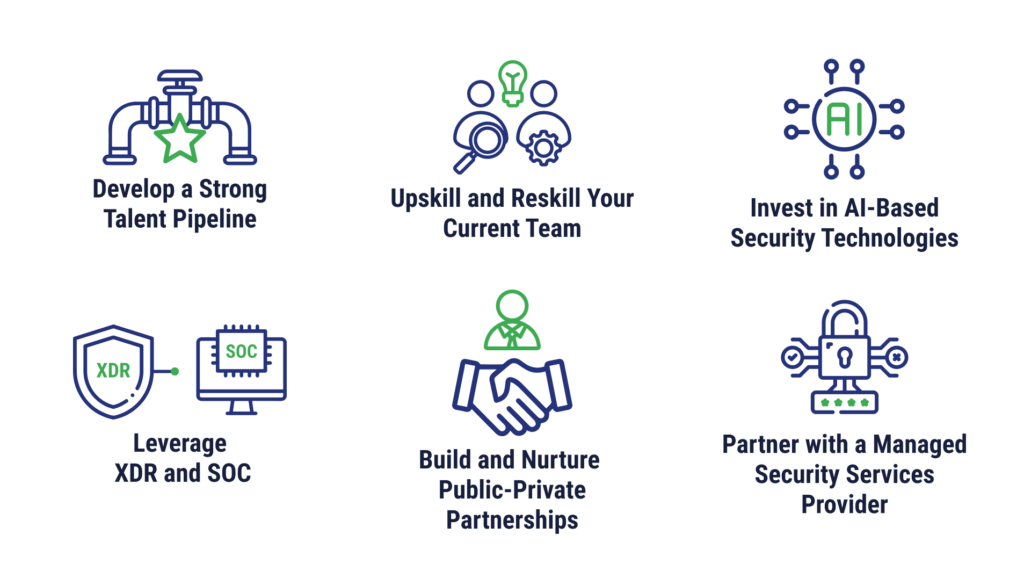
Many industries are experiencing a labor crunch, and cybersecurity is no different. Cybersecurity staff are vital to keeping an organization’s critical assets, like systems and data, protected from cyberattacks.
What’s the Current State of the Cybersecurity Workforce Shortage?
The global cybersecurity workforce shortage is projected to reach 85 million workers globally by 2030, according to the World Economic Forum. While the cybersecurity workforce grew between 2022 and 2023 by 12.6%, this is still not enough to satisfy a gap of four million workers that are needed urgently to fill key cybersecurity jobs.
North America is one of the areas hardest hit by the talent shortage, which was short 522,000 people according to the report last year. These numbers show an urgent need to build and invest in the talent pool to improve the pipeline, but they also indicate a need for companies to think differently about filling these roles.
What’s Causing the Cybersecurity Shortage?
There isn’t just one factor contributing to the cybersecurity shortages – several issues are responsible for maintaining the current gap.
Education and Skills Training Gaps
Cybersecurity professionals need to understand the threat landscape and how to stay current with protecting against a wide variety of attacks, something that educational systems and training programs can struggle to accomplish at the same pace as evolving threats.
From a numbers perspective alone, universities are generally not producing enough graduates to satisfy the growing needs of businesses. When paired with insufficient curricula and challenges associated with effectively upskilling or reskilling current professionals, there are several places where educational gaps are appearing.
Lack of Resources
Sometimes, shortages also arise from insufficient resources on the side of hiring organizations. If businesses fail to allocate enough funds for the right cybersecurity talents, place a lower priority on cybersecurity hiring, or struggle with finding the time to hire and train cybersecurity professionals, it can feel even harder to overcome the skills gap.
Increased Competition to Secure Talent
In a high-demand environment, qualified professionals have their pick of places to work. Organizations with less desirable geographic locations, fewer perks, and less competitive offers can find themselves scrambling to retain talent.
Shift in Global Talent Distribution
Competition now extends far beyond your immediate community. The interconnectedness of the world and the rise of remote work mean that cybersecurity professionals can choose from opportunities within a global market. Conversely, geopolitical tensions can limit the ability of cybersecurity workers to move freely across countries, which can reduce the talent pool and prevent businesses from hiring workers from other regions. These opposing forces can shift global talent distribution considerably.
The Impact of the Cybersecurity Shortage
Businesses of all sizes can benefit from skilled cybersecurity talent, but it’s not always prioritized to secure effective professionals. Failing to address the gap in your own business can result in IT security gaps, financial risks, compliance issues, and economic challenges.

Security Gaps
Perhaps the most obvious issue that can arise from a lack of cybersecurity professionals is any security vulnerability or shortcoming. Businesses that leave cybersecurity roles unstaffed can become more susceptible to malware and ransomware, and become more vulnerable to cyberattacks in general. Without skilled professionals, organizations are more likely to be victims of data breaches. Even in a well-secured organization, security incidents can happen, and that’s where having incident response plans becomes incredibly important. If your team doesn’t have cybersecurity talent in place to implement an incident response plan, problems can cause unnecessary damage.
Financial Risks
In the short term, data breaches can cause all business processes to grind to a halt. Operational disruptions, even for a day or an hour, can result in significant revenue and productivity losses. For each outage, it’s estimated that losses can range from $10,000 to over $1,000,000, depending on the size and nature of your business.
If your business experiences a cyber incident due to gaps in policies and procedures, often managed by cybersecurity staff, it can be more difficult to obtain cyber insurance. For organizations already insured, premiums may rise significantly following an incident.
Failure to Meet Compliance
Many industries, like healthcare, have strict compliance requirements for businesses, particularly when it comes to cybersecurity issues that involve maintaining data privacy and security.
For example, a healthcare provider operating under HIPAA regulations may struggle to monitor access to patient records or conduct regular risk assessments without adequate security staff—leaving the organization vulnerable to fines and reputational damage following a breach.
Economic Challenges
Beyond initial cost burdens, cybersecurity shortage can also prevent innovation and digital transformation, resulting in a loss of any competitive edge. Organizations that are part of national or regional infrastructure and do not have sufficient cybersecurity talent on staff can become a prime target for cybercriminals, impacting national security and economic stability.
How to Close the Gap in the Cybersecurity Talent Shortage
How can businesses fight against opposing forces and close the gap in their own organization? Here are a few strategies you may want to implement.

Develop a Strong Talent Pipeline
Bringing in fresh talent can reduce the pressure of competing for experienced cybersecurity professionals, but it requires a commitment to training and development. If you have a senior team member who can help bridge the gap, consider hiring recent graduates or entry-level professionals and invest in upskilling them. With a clear career path and mentorship, you can build a capable, loyal team while strengthening your long-term security posture.
Upskill and Reskill Your Current Team
Upskilling and reskilling current employees is also an important part of reducing the impacts of the cybersecurity shortage. Investing in your current staff can make them feel more valued, improving retention rates and boosting employee satisfaction. You don’t always have to look outside for the right person – sometimes, they’re right in front of you.
Invest in AI-Based Security Technologies
While many cybersecurity tasks benefit from a trained eye, features like prioritization and automated alerts can be handled by AI-based security technologies. Working with an outside expert to choose tools, or asking current cybersecurity team members to recommend which technologies will work best for your business, can cut down on unnecessary manual tasks and free up current staff for tasks that require more sophisticated thinking.
Leverage XDR and SOC
One way to mitigate skill shortages is to adopt XDR. Extended Detection and Response (XDR) is a cybersecurity solution that collects and analyzes real-time data across your environment to identify and contain potential threats before they can disrupt operations. When integrated with the SOC (Security Operations Center), XDR enhances threat visibility and accelerates response, helping lean IT teams stay ahead of evolving cyber risks.
Together, these solutions provide automation and analytics to cut down on the time cybersecurity teams spend on various tasks. The tools streamline incoming information so that the staff working the SOC can make quicker decisions by using a single dashboard.
XDR and automation tools do not replace your IT staff and they don’t solve the demand for cybersecurity professionals entirely. But they do augment staff with the threat intelligence tools that enable your team to mitigate cyber risks and problem solve.
For businesses that still need to fill staffing gaps, we recommend working with a managed security services provider. Managed providers can help you manage security products, provide the experts via their own SOC, and work with you to find ways to continuously improve your security posture.
Build and Nurture Public-Private Partnerships
Depending on where your business is located, you may also be able to take advantage of a public-private partnership, an arrangement where governments and private-sector organizations work together to invest in things like cybersecurity talent. For example, Europe has implemented Horizon 2002 and the European Cybersecurity Investment Platform, while the U.S. started the United States Cybersecurity and Infrastructure Agency (CISA).
Partner with a Managed Security Services Provider
If you can’t wait to fill a cybersecurity role, are struggling with limited resources, or don’t know where to start, working with a managed services provider can be a helpful first step. These partners bring deep security expertise, proven processes, and modern technologies that help close talent gaps and reduce risk. Whether you need to augment your internal team or fully outsource cybersecurity operations, a trusted provider can ease the pressure on your staff, improve your ability to detect and respond to threats, and help you maintain a secure environment.
Enhance Your Cybersecurity and Bridge Talent Gaps with TierPoint
Don’t let the shortage leave you vulnerable to security threats.
If you’re struggling to fill cybersecurity roles, consider partnering with a managed services provider like TierPoint. Our team combines AI-driven analytics with hands-on human expertise to deliver real-time threat detection, rapid incident response, and around-the-clock monitoring. We help reduce risk, minimize disruption, and give you peace of mind, so you can stay focused on your business.
Contact us today to learn more about how we can help your organization.

